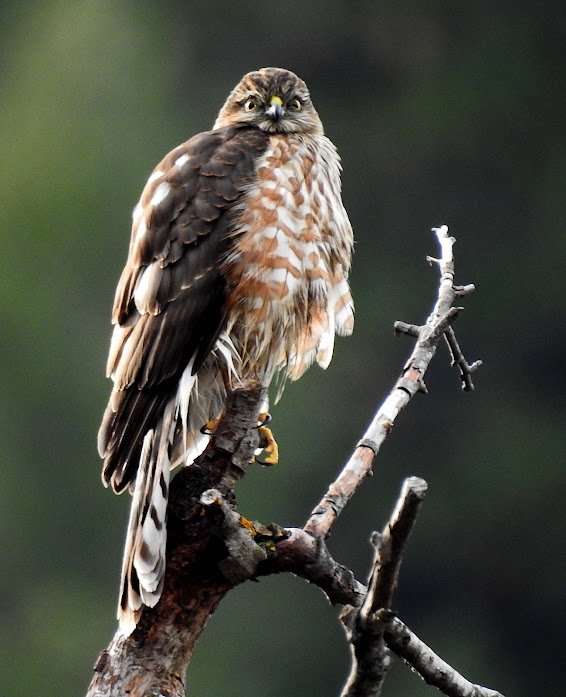Downy Woodpecker (female) - Dryobates pubescens
There are several types of woodpeckers that live year-round in our neighborhood, including the Hairy and Downy Woodpeckers, and the Northern Flicker. All woodpeckers have long tongues and several adaptations to absorb the shock of hammering on tree trunks.
Woodpecker tongues are so long, up to a third of their total body length, that they are coiled up and around the back of their skulls! Their tongue is actually a muscle-wrapped bone, the hyoid bone. The center of the hyoid is in the nostrils, in the bird's upper beak. It splits into a V between the eyes, and its two arms wrap completely around the woodpecker's skull, passing over the top of it and around the back before meeting up again at the base of the lower beak.
To protect their brains from getting too much damage from hammering, woodpeckers have elongated brain cases, layers of spongy bone inside their skull bone, and a minimal amount of cerebrospinal fluid surrounding their brain. They also have super strong necks that divert and absorb shock. When it pecks, the muscles in the woodpecker's neck absorb the shock of the pecking from the head and transmit it into the shoulders, upper torso, into the tail, and then back into the tree, in a circular dispersion of energy!
Researchers have found that all of these adaptations absorb up to 99.7% of the shock of the woodpeckers hammering!
Here's a video I took of a Hairy Woodpecker hammering away, right outside my studio window!
Hairy Woodpecker (male) - Dryobates villosus
Hairy and Downy Woodpeckers have very similar feather patterns that can make them difficult to distinguish in the field. The males have red feathers on the back of their heads, which the females lack. The Hairy Woodpecker (9.25") is larger overall than the Downy Woodpecker (6.75"). To me, the obvious difference is the size of their bill. The Downy's bill is not near as long as the Hairy's bill.
Northern Flicker (male) - Colaptes auratus
The Northern Flicker feeds mainly on insects on the ground, such as carpenter ants and beetles in the spring and summer, and switches to fruits and seeds in the fall. Right now they are probably feeding on poison oak berries and a variety of native seeds. The male Northern Flicker can be distinguished by its bright red malar, which the female doesn't have.
Isn't it amazing how the pattern of the feathers near the base of the tail look like little, black, orchid flowers!!!
Northern Flicker (female) - Colaptes auratus
Northern Flickers will hammer holes in trees when making a nest, but not to get wood-boring grubs to eat. They will however, hammer into the ground when searching for insects.
Red-breasted Sapsucker - Sphyrapicus ruber
Foothill Woodpeckers
There are different woodpeckers at different elevations in California. Some stay year-round in one area, while others are short-distance migrants that move up and down in elevation with the seasons.
The Red-breasted Sapsucker pictured above spends the winter in the foothills, coast, and central valley of California. They move up to our neighborhood as well as the Lakes Basin in the spring, to breed and raise their young.
Here are photos of all the woodpeckers I've seen in my local excursions. I have written about them all in previous blogs. Just type in their name in the "search this blog" bar on the top right of this page (not visible on a phone - only visible on a computer screen) to learn more about each woodpecker.
Nuttall's Woodpecker (female) - Dryobates nuttallii
Acorn Woodpecker (female) - Melanerpes formicivorus
Lewis's Woodpecker (male) - Melanerpes lewis
Pileated Woodpecker (male) - Dryocopus pileatus
Lakes Basin Woodpeckers
Here are some woodpeckers that I've mainly seen in the Lakes Basin.
Some live there all year and some don't!
White-headed Woodpecker (male) - Dryobates albolarvatus
Chickaree - Western Gray Squirrel
Tamiasciurus douglasii - Sciurus griseus
Local Mammal Update
New this week I've seen several deer, three does and one buck, and a young fox in our neighborhood! The Western Gray Squirrels and Chickarees are as busy as ever looking for seeds to eat!
Columbian Black-tailed Deer (buck) - Odocoileus hemionus columbianus
Columbian Black-tailed Deer (does) - Odocoileus hemionus columbianus
Grey Fox (adult - juvenile) - Urocyon cinereoargenteus
The Sierra Buttes - 1/26/23
Local Weather
It's been sunny and cold this week with no precipitation. A short, snowy, storm is supposed to arrive tonight and last through tomorrow (Sat-Sun). My husband and I took advantage of the dry road (it had been REALLY icy) and drove up to see the Sierra Buttes last Thursday. We ended up hiking on the groomed, snowy Gold Lake Road for a couple of miles. No one else was there! it was sunny and warm in the sun, and it wasn't icy at all! We measured 2.5'-3' of snow alongside the groomed road. The Sierra Buttes were gorgeous as always! We hope to get back up there next week!
What's happening in the foothills and the Central Valley?
Check back next week for the answers to these questions and more!
Unfortunately, you can no longer sign up to get my blog via email. Just go to northyubanaturalist.blogspot.com directly.
Your questions and comments are greatly appreciated. Please feel free to email me at northyubanaturalist@gmail.com. Thanks!
.jpg)




.JPG)
.jpg)
.JPG)




















.JPG)

.JPG)

















